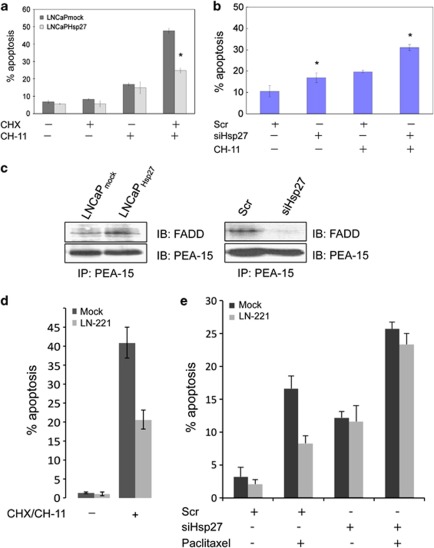Figure 5.
Hsp27 regulates Fas-induced apoptosis by modulating FADD binding to PEA-15. (a) Hsp27 suppresses Fas-induced apoptosis. LNCaPmock and LNCaPHsp27 cells were treated with either 2.5 μg/ml CHX alone, 1.0 μg/ml agonistic anti-Fas antibody (CH-11) alone or in combination in 5% charcoal-stripped serum media. Apoptosis was assessed by measuring the percentage cells containing subdiploid DNA (% sub-G1) as determined by propidium iodide staining and flow cytometry 24 h after treatment. (b) Hsp27 silencing promotes Fas-induced apoptosis. At 48 h after transfection of LNCaP cells with 20 nM Scr or 20 nM siHsp27, apoptosis in response to CH-11 was assessed as above. (c) Hsp27 regulates association of PEA-15 with FADD. PEA-15 was immunoprecipitated from cell lysates from LNCaPmock and LNCaPHsp27 cells and from LNCaP cells transfected with 20 nM Scr or 20 nM siHsp27 and cultured for 24 h. Immune complexes were resolved on SDS-PAGE and immunoblotted for FADD and PEA-15. (d) PEA-15 silencing protects from Fas-induced apoptosis. LNCaPmock and LN-221 cells were treated in the presence or absence of 2.5 μg/ml CHX and 1.0 μg/ml CH-11. Apoptosis was assessed 24 h after treatment. (e) Role of PEA-15 in intrinsic apoptosis. LNCaPmock and LN-221 cells were treated with Scr or siHsp27 in the presence or absence of paclitaxel. Percentage of cells undergoing apoptosis was measured as above. The results (a, b, d and e) are the means of three independent experiments. Values shown represent mean±S.D. The symbol ‘*' denotes statistical significance (P<0.05)

